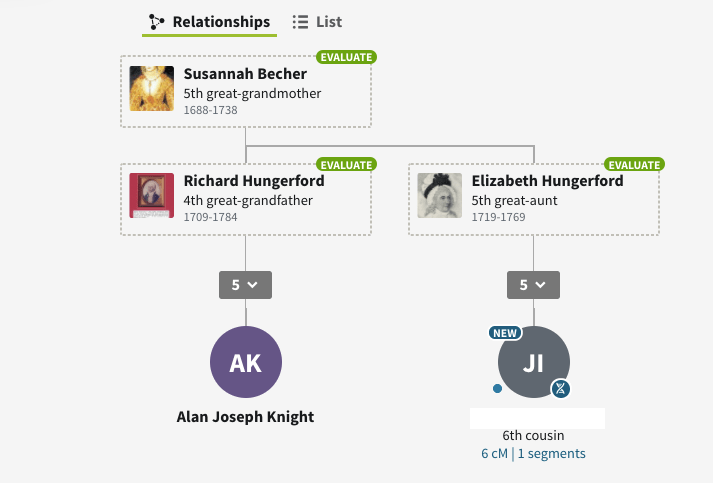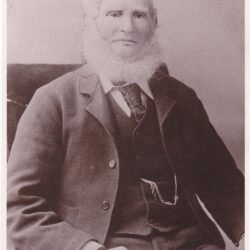Following the story that John Knight appeared to be the son of Emanuel Hungerford, John’s great-grandson Alan Knight did an AncestryDNA® test and a Y-DNA test to confirm this link to the Hungerfords. Our former HAFS president John BS Hungerford did the same so we had a comparison. The results were exciting and a bit surprising! With their permission, we share some highlights.
Alan’s Ancestry DNA test shows that his great-grandfather John Knight was most definitely a Hungerford. Ancestry’s ThruLines™ feature shows relationships between Alan and 14 people descended from different lines from Emanuel Hungerford, including HAFS president Lesley Abrahams.

Alan Knight is four generations removed from Emanuel Hungerford and John Hungerford is five, making Alan and John half fourth cousins once removed, I believe. The amount of shared autosomal DNA between them falls below Ancestry’s threshold for showing them in each other’s results, which was a bit disappointing.
On the other hand, Alan’s results clearly show Daunt and Busteed ancestry through at least four people who are not descendants of Emanuel Hungerford. Peter Sherlock, who has recently been documenting the complete ancestry of Emanuel, describes it like this:
“On the Daunt group of matches: there are four matches to 2x and 3x great grandchildren of William Henry Daunt and Jane Busteed (one match with initials RD). Their tree links to Emanuel’s mother Ann Daunt, in multiple ways:
- William Henry Daunt m 1845 in Cork to Jane Busteed.
- Their parents were Henry Daunt & Honora Maria Cotter, Henry Busteed & Letitia Daunt.
- Letitia’s parents: Thomas Digby Daunt & Frances Daunt.
- Letitia’s grandparents (her grandfathers were cousins): Thomas Daunt & Letitia Digby, Achilles Daunt & Frances French.
- Letitia’s great-grandparents: Henry Daunt & Ann Knolles (x 2).
Thus RD’s 6-great grandparents on two lines are Henry Daunt and Ann Knolles, who are Emanuel’s first great-grandparents. Therefore RD would be something like a double 6th cousin to many of Emanuel’s descendants, with a few extra doses coming in from the Hungerfords and Daunts further back on several Daunt, Knolles and Busteed lines.”
Peter Sherlock also immediately saw that several matches were related through descendants of Emanuel’s brother Thomas Achilles Hungerford, whose daughter Elizabeth Hungerford married Richard Mellefont and emigrated to New York, USA.
In the next diagram, we can see that Alan is related to a sixth cousin with initials JI through his 5th great-grandmother Susanna Becher and her daughter Elizabeth. There are numerous other examples of the Hungerford ancestry that Alan has through John Knight.

Despite these matches with people in the UK and USA, Alan Knight only appears in a handful of our Australian DNA tests because, firstly, genetically he is closer to Emanuel and his ancestors than many of us are; and secondly, he only shares one ancestor with most Australian Hungerfords (ie Emanuel). Most Australian Hungerfords share Emanuel and Catherine Loane as ancestors, and those of us from the E.1, E.2 and E.4 branches also share Winder and Johnson ancestors.
Although the first diagram above shows Emanuel as John Knight’s father, this could be because that’s what is in Alan’s tree and it closely fits the DNA matches and their trees. We might have found a similar diagram if we had one of Emanuel’s siblings as John’s parent instead.
How can we be certain that John Knight wasn’t a child of Emanuel’s sister or a female cousin? This would be a plausible explanation for the baby being taken under Emanuel’s guardianship. This where the Y-DNA test is important.
The Y-DNA results – the paternity test
To check that John Knight’s father was Emanuel Hungerford, Alan Knight and John BS Hungerford both did a FamilyTreeDNA™ Y-DNA test (a Y-111 test to be precise). Y-DNA is only passed down the generations from father to son only and mutates more slowly than autosomal DNA (the sort tested by AncestryDNA). Therefore, it can indicate there are shared paternal ancestors many generations back – perhaps 500 years back.
We waited rather anxiously and were greatly relieved when the results showed that Alan and John are Y-DNA matches. They are both descended from a Hungerford man who must be Emanuel or one of his patrilineal ancestors. The test says they have a genetic distance of three, which is not three generations, but a total of steps of mutation out of 111 markers tested. FamilyTreeDNA™ says “matches at this level are related as 9th cousins or closer, and over half will be 5th or more recent cousins”. This is consistent with the hypothesis that Emanuel was John Knight’s father, although it doesn’t preclude the less likely scenario that one of his brothers was the father.
To be more certain, we need more autosomal (AncestryDNA) matches that are closer than Alan and John – ideally people in the “b” or “c” generation within our HAFS coding system. We would also like more Y-DNA matches from descendants of Emanuel’s brothers lines (i.e. the J or B lines), and a male descendant from each of Emanuel’s and John Knight’s sons to compare the distances. With these, we might be able to triangulate these results more accurately.
A Hungerford Y-DNA Project
Surprisingly, there is no dedicated Hungerford surname (Y-DNA) project yet at FamilyTreeDNA™. These are listed on the FamilyTreeDNA™ website for other people around the world who meet the research criteria and they are moderated by one or more group administrators. In due course, we might request one if there is interest. Meantime, US and UK Hungerford males might find it interesting to just do the test individually and see who they match. There are several other men in the Y-DNA matches for Alan Knight and John Hungerford, a couple who don’t have the Hungerford surname. There are other stories to be discovered!
If you did a Y-DNA test many years ago, you could send us your printed results for comparison, but it would be better to do a new test. They test more markers and they provide online information with contact details of people you match, and email notification of new matches.
If you’re not sure, we have a list of Australian and New Zealand people who would be good candidates for the Y-DNA tests for this project. Thanks to a generous donation from an interested member, we can offer two free Y-DNA kits to men who closely fit the requirements, so if you are interested to know more, please send us a message. We can help with instructions on how to order and complete the tests. We also have several Ancestry kits left for A$89 plus postage.
Who was John Knight’s mother?
Assuming Emanuel is John Knight’s father, the question is “who was John Knight’s mother”? It is quite clear from the AncestryDNA® results that it was not Catherine Loane as there are no Loanes appearing in the trees of the DNA matches (except the Australian Hungerford matches descended from Emanuel as you would expect).
Perhaps the mother was a young woman from a wealthy family whose reputation had to be protected. Perhaps she was an unmarried woman with no means to care for a child, which might explain why John Knight couldn’t read or write. Was the mother’s surname Knight or was that a name given to hide the identity of the real mother? We are hoping to deduce this from the AncestryDNA® by a process of elimination. Amongst Alan’s many matches are some people who have the surname Knight in their tree. There are other matches whose family stems from Kilbrittain and other parts of Cork in Ireland. With more traditional genealogical techniques and a few more AncestryDNA® tests by older Knight descendants, the answer to this question might one day be known.
Many thanks to Alan Knight and John BS Hungerford for doing the DNA tests and sharing information, and special thanks to Peter Sherlock who first spotted the Knight DNA in his father’s results and has checked Alan’s results against his ongoing research.


